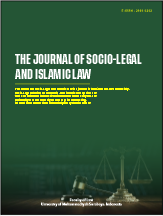The Worker's Commitment To Preventing Corruption As A Solution To Small Industrial Relations Disputes
Abstract
This research is motivated by the existence of industrial relations disputes which can be one of the causes of disruption of work security and peace. If it is not resolved immediately, it can result in loss of rights, loss of life and disruption of state security and stability. The role of employers is very important in preventing industrial relations disputes. The purpose of this study is to determine and analyze the employer's commitment to preventing corruption. The research method used is descriptive qualitative with a deductive approach. The result of this research is that the prevention of corruption in industrial relations can be initiated from the employer's commitment. The steps taken in implementing the commitment to prevent corruption are planning, implementing, evaluating, improving and feedback. An open corruption prevention system can create trust among parties in industrial relations. The conclusion and implication of this research is that the employer's commitment to preventing corruption in an open manner through the planning, implementation, evaluation, improvement and feedback stages can minimize industrial relations disputes.
Keywords: commitment, employer, corruption, dispute, industrial relations.
References
Brinkerhoff, D. W. (2000). Assessing political will for anti-corruption efforts: An analytic framework. Public Administration and Development, 20(3). https://doi.org/10.1002/1099-162X(200008)20:3<239::AID-PAD138>3.0.CO;2-3
Buttle, J. W., Graham Davies, S., & Meliala, A. E. (2016). A cultural constraints theory of police corruption: Understanding the persistence of police corruption in contemporary Indonesia. Australian and New Zealand Journal of Criminology, 49(3). https://doi.org/10.1177/0004865815573875
Charron, N. (2014). Do corruption measures have a perception problem? Assessing the relationship between experiences and perceptions of corruption among citizens and experts. European Political Science Review, 8(1). https://doi.org/10.1017/S1755773914000447
Cuervo-Cazurra, A. (2016). Corruption in international business. Journal of World Business, 51(1). https://doi.org/10.1016/j.jwb.2015.08.015
Damoah, I. S., & Kumi, D. K. (2018). Causes of government construction projects failure in an emerging economy: Evidence from Ghana. International Journal of Managing Projects in Business, 11(3). https://doi.org/10.1108/IJMPB-04-2017-0042
Graycar, A., & Sidebottom, A. (2012). Corruption and control: A corruption reduction approach. Journal of Financial Crime, 19(4). https://doi.org/10.1108/13590791211266377
Gunduz, M., & Önder, O. (2013). Corruption and Internal Fraud in the Turkish Construction Industry. Science and Engineering Ethics, 19(2). https://doi.org/10.1007/s11948-012-9356-9
Hauser, C., & Hogenacker, J. (2014). Do firms proactively take measures to prevent corruption in their international operations? European Management Review, 11(3–4). https://doi.org/10.1111/emre.12035
Idemobi, E. (2017). Influence of Industrial Relations on the Management of Industrial Dispute (A Study of Selected Private Enterprises in Delta State). Journal of Investment and Management, 6(3). https://doi.org/10.11648/j.jim.20170603.12
Jeppesen, K. K. (2019). The role of auditing in the fight against corruption. British Accounting Review, 51(5). https://doi.org/10.1016/j.bar.2018.06.001
Langseth, P. (2001). Prevention : An Effective Tool to Reduce Corruption Vienna , December. Global Programme Against Corruption Conferences - Responding to the Challenge of Corruption, 19 November 1999, Milan, May.
Moreto, W. D., Brunson, R. K., & Braga, A. A. (2015). Such misconducts don’t make a good ranger: Examining law enforcement ranger wrongdoing in Uganda. British Journal of Criminology, 55(2). https://doi.org/10.1093/bjc/azu079
Muthukrishna, M., Francois, P., Pourahmadi, S., & Henrich, J. (2017). Corrupting cooperation and how anti-corruption strategies may backfire. Nature Human Behaviour, 1(7). https://doi.org/10.1038/s41562-017-0138
Othman, R., Aris, N. A., Mardziyah, A., Zainan, N., & Amin, N. M. (2015). Fraud Detection and Prevention Methods in the Malaysian Public Sector: Accountants’ and Internal Auditors’ Perceptions. Procedia Economics and Finance, 28. https://doi.org/10.1016/s2212-5671(15)01082-5
Peltier-Rivest, D. (2017). The prevention and detection of corruption in pharmaceutical companies. Pharmaceuticals Policy and Law, 19(1–2). https://doi.org/10.3233/PPL-170451
Rabl, T. (2011). The Impact of Situational Influences on Corruption in Organizations. Journal of Business Ethics, 100(1). https://doi.org/10.1007/s10551-011-0768-2
Routledge Companion to Philosophy of Religion. (2013). In Routledge Companion to Philosophy of Religion. https://doi.org/10.4324/9780203813010
Scerri, A. (2014). Comfortably inhabiting reality: justifying and denouncing arguments in a development dispute in the post-industrial gentrified inner-city. Space and Polity, 18(1). https://doi.org/10.1080/13562576.2013.878070
Seregig, I. K., Suryanto, T., Hartono, B., Rivai, E., & Prasetyawati, E. (2018). Preventing the acts of corruption through legal community education. Journal of Social Studies Education Research, 9(2). https://doi.org/10.17499/jsser.65190
Slager, R. (2017). The Discursive Construction of Corruption Risk. Journal of Management Inquiry, 26(4). https://doi.org/10.1177/1056492616686839
Tanaka, S. (2001). Corruption in education sector development: A suggestion for anticipatory strategy. In International Journal of Educational Management (Vol. 15, Issue 4). https://doi.org/10.1108/09513540110394384
van der Wal, Z., Graycar, A., & Kelly, K. (2016). See No Evil, Hear No Evil? Assessing Corruption Risk Perceptions and Strategies of Victorian Public Bodies. Australian Journal of Public Administration, 75(1). https://doi.org/10.1111/1467-8500.12163
Waschull, S., Wortmann, J. C., & Bokhorst, J. A. C. (2018). Manufacturing execution systems: The next level of automated control or of shop-floor support? IFIP Advances in Information and Communication Technology, 536. https://doi.org/10.1007/978-3-319-99707-0_48
Wijayant, AsriB. S. A. Subagyono, A. Y. Hernoko, Z. V. Chumaida, and Y. Sugiarti. (2019). Technological Advocacy of Migrant Workers in The Pre Placement Based on Personal Legal Assistance. International Journal of Recent Technology and Engineering, 8(2S11). https://doi.org/10.35940/ijrte.b1347.0982s1119
Wijayant, A., & Nafiah, A. (2019). Payment of wage under minimum wage for abdi dalem sultan palace (Daerah istimewa yogyakarta). Humanities and Social Sciences Reviews, 7(3). https://doi.org/10.18510/hssr.2019.738
Wijayanti, A. (2012). Critical Analysis of the Minimum Wages in Order to Achieve Substantive Justice. SSRN Electronic Journal. https://doi.org/10.2139/ssrn.2183624
Wijayanti, A. (2018). Implementation of Javanese Local Wisdom Principles as Alternative Solution for Non-Litigation Legal Aid Model for Marginal Community. https://doi.org/10.5220/0007421804190424
Wijayanti, A. (2020). Al Ujroh as an Alternative of a Fair Wage Setting Solution. https://doi.org/10.2991/icss-18.2018.263
Wjayanti, A., & Suhartono, S. (2019). Establishing Trade Union in the Climate Change of Employment. International Journal of Civil Engineering and Technology (IJCIET), 10(3).
Wu, J. (2014). The antecedents of corporate social and environmental irresponsibility. Corporate Social Responsibility and Environmental Management, 21(5). https://doi.org/10.1002/csr.1335
Zhou, K., Liu, T., & Zhou, L. (2016). Industry 4.0: Towards future industrial opportunities and challenges. 2015 12th International Conference on Fuzzy Systems and Knowledge Discovery, FSKD 2015, 2147–2152. https://doi.org/10.1109/FSKD.2015.7382284
Downloads
Published
How to Cite
Issue
Section
License
Copyright (c) 2023 Dedy Stansyah

This work is licensed under a Creative Commons Attribution 4.0 International License.






